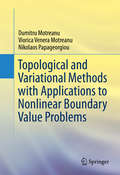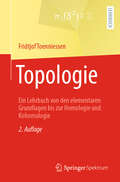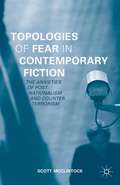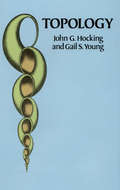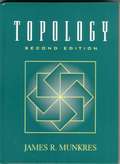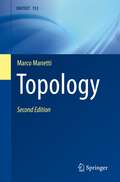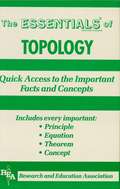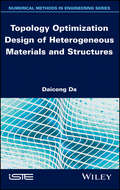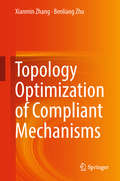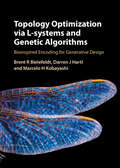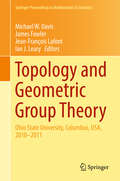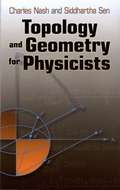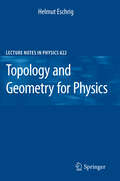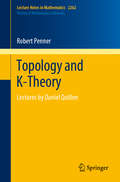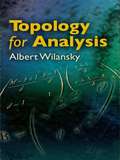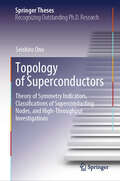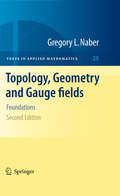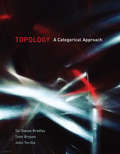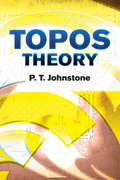- Table View
- List View
Topological and Non-Topological Solitons in Scalar Field Theories (Cambridge Monographs on Mathematical Physics)
by Yakov M. ShnirSolitons emerge in various non-linear systems as stable localized configurations, behaving in many ways like particles, from non-linear optics and condensed matter to nuclear physics, cosmology and supersymmetric theories. This book provides an introduction to integrable and non-integrable scalar field models with topological and non-topological soliton solutions. Focusing on both topological and non-topological solitons, it brings together debates around solitary waves and construction of soliton solutions in various models and provides a discussion of solitons using simple model examples. These include the Kortenweg-de-Vries system, sine-Gordon model, kinks and oscillons, and skyrmions and hopfions. The classical field theory of scalar field in various spatial dimensions is used throughout the book in presentation of related concepts, both at the technical and conceptual level. Providing a comprehensive introduction to the description and construction of solitons, this book is ideal for researchers and graduate students in mathematics and theoretical physics.
Topological and Statistical Methods for Complex Data
by Valerio Pascucci Janine Bennett Fabien VivodtzevThis book contains papers presented at the Workshop on the Analysis of Large-scale, High-Dimensional, and Multi-Variate Data Using Topology and Statistics, held in Le Barp, France, June 2013. It features the work of some of the most prominent and recognized leaders in the field who examine challenges as well as detail solutions to the analysis of extreme scale data. The book presents new methods that leverage the mutual strengths of both topological and statistical techniques to support the management, analysis, and visualization of complex data. It covers both theory and application and provides readers with an overview of important key concepts and the latest research trends. Coverage in the book includes multi-variate and/or high-dimensional analysis techniques, feature-based statistical methods, combinatorial algorithms, scalable statistics algorithms, scalar and vector field topology, and multi-scale representations. In addition, the book details algorithms that are broadly applicable and can be used by application scientists to glean insight from a wide range of complex data sets.
Topological and Variational Methods with Applications to Nonlinear Boundary Value Problems
by Dumitru Motreanu Viorica Venera Motreanu Nikolaos PapageorgiouThis book focuses on nonlinear boundary value problems and the aspects of nonlinear analysis which are necessary to their study. The authors first give a comprehensive introduction to the many different classical methods from nonlinear analysis, variational principles, and Morse theory. They then provide a rigorous and detailed treatment of the relevant areas of nonlinear analysis with new applications to nonlinear boundary value problems for both ordinary and partial differential equations. Recent results on the existence and multiplicity of critical points for both smooth and nonsmooth functional, developments on the degree theory of monotone type operators, nonlinear maximum and comparison principles for p-Laplacian type operators, and new developments on nonlinear Neumann problems involving non-homogeneous differential operators appear for the first time in book form. The presentation is systematic, and an extensive bibliography and a remarks section at the end of each chapter highlight the text. This work will serve as an invaluable reference for researchers working in nonlinear analysis and partial differential equations as well as a useful tool for all those interested in the topics presented.
Topologie: Ein Lehrbuch von den elementaren Grundlagen bis zur Homologie und Kohomologie
by Fridtjof ToenniessenDiese Einführung in die Topologie spannt einen weiten Bogen, von den elementaren Grundlagen über fortgeschrittene Themen der algebraischen Topologie bis hin zu tiefer liegenden Meilensteinen, die im 20. Jahrhundert Furore gemacht haben. Der Text ist durchgängig einfach geschrieben, braucht nur wenig Vorwissen und ist daher gut geeignet ab etwa dem dritten Semester eines mathematischen Bachelorstudiums. Er wurde für die 2. Auflage vollständig durchgesehen, didaktisch und redaktionell überarbeitet sowie in weiten Teilen ergänzt und korrigiert. Erhalten blieb dabei der aufgelockerte Lesebuch-Charakter. So erfahren Sie bei der Lektüre hie und da historische Fakten oder werden in die Gedankengänge von Mathematikern versetzt, um die Entstehung der Theorie Schritt für Schritt nacherleben zu können. Dabei geht es naturgemäß nicht immer geradeaus, manchmal führe ich Sie auf Holzwege, die einerseits zum Nachdenken und zu einer kritischen Reflexion anregen, andererseits aber auch zeigen sollen, dass die Definitionen nicht einfach vom Himmel gefallen sind, sondern sich organisch entwickelt haben. Zahlreiche konkrete Beispiele und fast 400 Abbildungen runden den Stoff ab.
Topologies of Fear in Contemporary Fiction: The Anxieties of Post-Nationalism and Counter Terrorism
by Scott McClintockThe central concern of the book is the impact of global terror networks and state counterterrorism on twentieth-century fiction. A unique contribution of this book is the comparative approach, as opposed to the single author focus of most of the edited collections on terrorism in literature.
Topology
by John G. Hocking Gail S. Young"As textbook and reference work, this is a valuable addition to the topological literature." -- Mathematical ReviewsDesigned as a text for a one-year first course in topology, this authoritative volume offers an excellent general treatment of the main ideas of topology. It includes a large number and variety of topics from classical topology as well as newer areas of research activity.There are four set-theoretic chapters, followed by four primarily algebraic chapters. Chapter I covers the fundamentals of topological and metrical spaces, mappings, compactness, product spaces, the Tychonoff theorem, function spaces, uniform continuity and uniform spaces. The next two chapters are devoted to topics in point-set topology: various separation axioms, continua in Hausdorff spaces, real-valued functions, and more Chapter IV is on homotopy theory. Chapter V covers basic material on geometric and abstract simplicial complexes and their subdivisions. Chapter VI is devoted to simplicial homology theory, Chapter VII covers various topics in algebraic topology, including relative homology, exact sequences, the Mayer-Vietoris sequence, and more. Finally, Chapter VIII discusses Cech homology.There are a large number of illuminating examples, counter-examples and problems, both those which test the understanding and those which deepen it. The authors have also made a special effort to make this an "open-ended" book, i.e while many topics are covered, there is much beyond the confines of this book. In many instances they have attempted to show the direction in which further material may be found.Topology is so fundamental, its influence is apparent in almost every other branch of mathematics, as well as such fields as symbolic logic, mechanics, geography, network theory, and even psychology. This well-written text offers a clear and careful exposition of this increasingly important discipline.
Topology
by James R. MunkresThis introduction to topology provides separate, in-depth coverage of both general topology and algebraic topology. Includes many examples and figures. GENERAL TOPOLOGY. Set Theory and Logic. Topological Spaces and Continuous Functions. Connectedness and Compactness. Countability and Separation Axioms. The Tychonoff Theorem. Metrization Theorems and paracompactness. Complete Metric Spaces and Function Spaces. Baire Spaces and Dimension Theory. ALGEBRAIC TOPOLOGY. The Fundamental Group. Separation Theorems. The Seifert-van Kampen Theorem. Classification of Surfaces. Classification of Covering Spaces. Applications to Group Theory. For anyone needing a basic, thorough, introduction to general and algebraic topology and its applications.
Topology
by Marco ManettiThis is an introductory textbook on general and algebraic topology, aimed at anyone with a basic knowledge of calculus and linear algebra. It provides full proofs and includes many examples and exercises. The covered topics include: set theory and cardinal arithmetic; axiom of choice and Zorn's lemma; topological spaces and continuous functions; connectedness and compactness; Alexandrov compactification; quotient topologies; countability and separation axioms; prebasis and Alexander's theorem; the Tychonoff theorem and paracompactness; complete metric spaces and function spaces; Baire spaces; homotopy of maps; the fundamental group; the van Kampen theorem; covering spaces; Brouwer and Borsuk's theorems; free groups and free product of groups; and basic category theory. While it is very concrete at the beginning, abstract concepts are gradually introduced. It is suitable for anyone needing a basic, comprehensive introduction to general and algebraic topology and its applications.
Topology
by Stefan WaldmannThis book provides a concise introduction to topology and is necessary for courses in differential geometry, functional analysis, algebraic topology, etc. Topology is a fundamental tool in most branches of pure mathematics and is also omnipresent in more applied parts of mathematics. Therefore students will need fundamental topological notions already at an early stage in their bachelor programs. While there are already many excellent monographs on general topology, most of them are too large for a first bachelor course. Topology fills this gap and can be either used for self-study or as the basis of a topology course.
Topology (UNITEXT #153)
by Marco ManettiThis is an introductory textbook on general and algebraic topology, aimed at anyone with a basic knowledge of calculus and linear algebra. It provides full proofs and includes many examples and exercises. The covered topics include: set theory and cardinal arithmetic; axiom of choice and Zorn's lemma; topological spaces and continuous functions; con- nectedness and compactness; Alexandrov compactification; quotient topol- ogies; countability and separation axioms; prebasis and Alexander's theorem; the Tychonoff theorem and paracompactness; complete metric spaces and function spaces; Baire spaces; homotopy of maps; the fundamental group; the van Kampen theorem; covering spaces; Brouwer and Borsuk's theorems; free groups and free product of groups and basic category theory. While it is very concrete at the beginning, abstract concepts are gradually introduced. This second edition contains a new chapter with a topological introduction to sheaf cohomology and applications. It also corrects some inaccuracies and some additional exercises are proposed. The textbook is suitable for anyone needing a basic, comprehensive introduction to general and algebraic topology and its applications.
Topology Essentials
by Emil G. MilewskiREA's Essentials provide quick and easy access to critical information in a variety of different fields, ranging from the most basic to the most advanced. As its name implies, these concise, comprehensive study guides summarize the essentials of the field covered. Essentials are helpful when preparing for exams, doing homework and will remain a lasting reference source for students, teachers, and professionals. Topology includes an overview of elementary set theory, relations and functions, ordinals and cardinals, topological spaces, continuous functions, metric spaces and normed spaces, countable spaces, and separation axioms.
Topology Optimization Design of Heterogeneous Materials and Structures
by Daicong DaThis book pursues optimal design from the perspective of mechanical properties and resistance to failure caused by cracks and fatigue. The book abandons the scale separation hypothesis and takes up phase-field modeling, which is at the cutting edge of research and is of high industrial and practical relevance. Part 1 starts by testing the limits of the homogenization-based approach when the size of the representative volume element is non-negligible compared to the structure. The book then introduces a non-local homogenization scheme to take into account the strain gradient effects. Using a phase field method, Part 2 offers three significant contributions concerning optimal placement of the inclusion phases. Respectively, these contributions take into account fractures in quasi-brittle materials, interface cracks and periodic composites. The topology optimization proposed has significantly increased the fracture resistance of the composites studied.
Topology Optimization of Compliant Mechanisms
by Xianmin Zhang Benliang ZhuThis book covers various topics regarding the design of compliant mechanisms using topology optimization that have attracted a great deal of attention in recent decades. After comprehensively describing state-of-the-art methods for designing compliant mechanisms, it provides a new topology optimization method for finding new flexure hinges. It then presents several attempts to obtain distributed compliant mechanisms using the topology optimization method. Further, it discusses a Jacobian-based topology optimization method for compliant parallel mechanisms, and introduces readers to the topology optimization of compliant mechanisms, taking into account geometrical nonlinearity and reliability. Providing a systematic method for topology optimization of flexure hinges, which are essential for designing compliant mechanisms, the book offers a valuable resource for all readers who are interested in designing compliant mechanism-based positioning stages. In addition, the methods for solving the de facto hinges in topology optimized compliant mechanisms will benefit all engineers seeking to design micro-electro-mechanical system (MEMS) structures.
Topology Optimization via L-Systems and Genetic Algorithms: Bioinspired Encoding for Generative Design
by Darren J. Hartl Brent R. Bielefeldt Marcelo H. KobayashiProviding a succinct overview of Lindenmayer system (L-system) topology optimization, this book focuses on the methods and theory underlying this novel bioinspired approach. Starting from basic principles, the book outlines how topology optimization can be utilized at the conceptual design stage and shows how it offers straightforward applicability to multi-objective and/or multi-physical industrial problems. Design strategies are clearly demonstrated using a host of case studies and real-world examples, and their potential challenges and solutions are discussed. Written from an optimization and design perspective, the authors both summarize the latest advances in this field and suggest potential avenues of research and development for future work. This will be the ideal resource for engineering practitioners, researchers, and students wanting to gain a new perspective on using topology optimization to improve product design.
Topology and Geometric Group Theory
by James Fowler Michael W. Davis Jean-François Lafont Ian J. LearyThis book presents articles at the interface of two active areas of research: classical topology and the relatively new field of geometric group theory. It includes two long survey articles, one on proofs of the Farrell-Jones conjectures, and the other on ends of spaces and groups. In 2010-2011, Ohio State University (OSU) hosted a special year in topology and geometric group theory. Over the course of the year, there were seminars, workshops, short weekend conferences, and a major conference out of which this book resulted. Four other research articles complement these surveys, making this book ideal for graduate students and established mathematicians interested in entering this area of research.
Topology and Geometry for Physicists
by Charles Nash Siddhartha SenDifferential geometry and topology are essential tools for many theoretical physicists, particularly in the study of condensed matter physics, gravity, and particle physics. Written by physicists for physics students, this text introduces geometrical and topological methods in theoretical physics and applied mathematics. It assumes no detailed background in topology or geometry, and it emphasizes physical motivations, enabling students to apply the techniques to their physics formulas and research. "Thoroughly recommended" by The Physics Bulletin, this volume's physics applications range from condensed matter physics and statistical mechanics to elementary particle theory. Its main mathematical topics include differential forms, homotopy, homology, cohomology, fiber bundles, connection and covariant derivatives, and Morse theory.
Topology and Geometry for Physics
by Helmut EschrigA concise but self-contained introduction of the central concepts of modern topology and differential geometry on a mathematical level is given specifically with applications in physics in mind. All basic concepts are systematically provided including sketches of the proofs of most statements. Smooth finite-dimensional manifolds, tensor and exterior calculus operating on them, homotopy, (co)homology theory including Morse theory of critical points, as well as the theory of fiber bundles and Riemannian geometry, are treated. Examples from physics comprise topological charges, the topology of periodic boundary conditions for solids, gauge fields, geometric phases in quantum physics and gravitation.
Topology and Its Applications
by William F. BasenerDiscover a unique and modern treatment of topology employing a cross-disciplinary approachImplemented recently to understand diverse topics, such as cell biology, superconductors, and robot motion, topology has been transformed from a theoretical field that highlights mathematical theory to a subject that plays a growing role in nearly all fields of scientific investigation. Moving from the concrete to the abstract, Topology and Its Applications displays both the beauty and utility of topology, first presenting the essentials of topology followed by its emerging role within the new frontiers in research.Filling a gap between the teaching of topology and its modern uses in real-world phenomena, Topology and Its Applications is organized around the mathematical theory of topology, a framework of rigorous theorems, and clear, elegant proofs.This book is the first of its kind to present applications in computer graphics, economics, dynamical systems, condensed matter physics, biology, robotics, chemistry, cosmology, material science, computational topology, and population modeling, as well as other areas of science and engineering. Many of these applications are presented in optional sections, allowing an instructor to customize the presentation.The author presents a diversity of topological areas, including point-set topology, geometric topology, differential topology, and algebraic/combinatorial topology. Topics within these areas include:Open sets Compactness Homotopy Surface classification Index theory on surfaces Manifolds and complexes Topological groups The fundamental group and homologySpecial "core intuition" segments throughout the book briefly explain the basic intuition essential to understanding several topics. A generous number of figures and examples, many of which come from applications such as liquid crystals, space probe data, and computer graphics, are all available from the publisher's Web site.
Topology and K-Theory: Lectures by Daniel Quillen (Lecture Notes in Mathematics #2262)
by Robert PennerThese are notes from a graduate student course on algebraic topology and K-theory given by Daniel Quillen at the Massachusetts Institute of Technology during 1979-1980. He had just received the Fields Medal for his work on these topics among others and was funny and playful with a confident humility from the start. These are not meant to be polished lecture notes, rather, things are presented as did Quillen reflected in the hand-written notes, resisting any temptation to change or add notation, details or elaborations. Indeed, the text is faithful to Quillen's own exposition, even respecting the {\sl board-like presentation} of formulae, diagrams and proofs, omitting numbering theorems in favor of names and so on. This is meant to be Quillen on Quillen as it happened forty years ago, an informal text for a second-semester graduate student on topology, category theory and K-theory, a potential preface to studying Quillen's own landmark papers and an informal glimpse of his great mind. The intellectual pace of the lectures, namely fast and lively, is Quillen himself, and part of the point here is to capture some of this intimacy. To be sure, much has happened since then from this categorical perspective started by Grothendieck, and Misha Kapranov has contributed an Afterword in order to make it more useful to current students.
Topology for Analysis (Dover Books on Mathematics)
by Albert WilanskyAppropriate for both students and professionals, this volume starts with the first principles of topology and advances to general analysis. Three levels of examples and problems, ordered and numbered by degree of difficulty, illustrate important concepts. A 40-page appendix, featuring tables of theorems and counter examples, provides a valuable reference.From explorations of topological space, convergence, and separation axioms, the text proceeds to considerations of sup and weak topologies, products and quotients, compactness and compactification, and complete semimetric space. The concluding chapters explore metrization, topological groups, and function spaces. Each subject area is supplemented with examples, problems, and exercises that progress to increasingly rigorous levels. All examples and problems are classified as essential, optional, and advanced.
Topology of Infinite-Dimensional Manifolds (Springer Monographs in Mathematics)
by Katsuro SakaiAn infinite-dimensional manifold is a topological manifold modeled on some infinite-dimensional homogeneous space called a model space. In this book, the following spaces are considered model spaces: Hilbert space (or non-separable Hilbert spaces), the Hilbert cube, dense subspaces of Hilbert spaces being universal spaces for absolute Borel spaces, the direct limit of Euclidean spaces, and the direct limit of Hilbert cubes (which is homeomorphic to the dual of a separable infinite-dimensional Banach space with bounded weak-star topology). This book is designed for graduate students to acquire knowledge of fundamental results on infinite-dimensional manifolds and their characterizations. To read and understand this book, some background is required even for senior graduate students in topology, but that background knowledge is minimized and is listed in the first chapter so that references can easily be found. Almost all necessary background information is found in Geometric Aspects of General Topology, the author's first book. Many kinds of hyperspaces and function spaces are investigated in various branches of mathematics, which are mostly infinite-dimensional. Among them, many examples of infinite-dimensional manifolds have been found. For researchers studying such objects, this book will be very helpful. As outstanding applications of Hilbert cube manifolds, the book contains proofs of the topological invariance of Whitehead torsion and Borsuk’s conjecture on the homotopy type of compact ANRs. This is also the first book that presents combinatorial ∞-manifolds, the infinite-dimensional version of combinatorial n-manifolds, and proofs of two remarkable results, that is, any triangulation of each manifold modeled on the direct limit of Euclidean spaces is a combinatorial ∞-manifold and the Hauptvermutung for them is true.
Topology of Superconductors: Theory of Symmetry Indicators, Classifications of Superconducting Nodes, and High-Throughput Investigations (Springer Theses)
by Seishiro OnoThis book develops a symmetry-based approach to superconductors, which enables us to efficiently diagnose topological and nodal superconductivity. Superconductivity has fascinated physicists since its first discovery. In particular, unconventional superconductivity, which arises from unusual attractive interactions between electrons, has been intensively studied for the last few decades. More recently, it turns out that topological nature of superconductivity is closely related to how electrons pair up. After reviewing the basic concepts of the symmetry-based analysis of band topology, the first part of this book discusses a generalization of symmetry-based indicators—an efficient way to diagnose topological insulating phases without full information on wave functions—to superconducting phases. The second part of this book develops a novel scheme to extensively classify superconducting nodes—geometry of gapless regions in the Bogoliubov quasiparticle spectrum—based on band topology.Finally, combining these two parts, this book proposes a systematic scheme to predict topological and nodal properties of the superconducting phase by considering various possible pairing symmetries.
Topology, Geometry and Gauge fields
by Gregory L. NaberLike any books on a subject as vast as this, this book has to have a point-of-view to guide the selection of topics. Naber takes the view that the rekindled interest that mathematics and physics have shown in each other of late should be fostered, and that this is best accomplished by allowing them to cohabit. The book weaves together rudimentary notions from the classical gauge theory of physics with the topological and geometrical concepts that became the mathematical models of these notions. The reader is asked to join the author on some vague notion of what an electromagnetic field might be, to be willing to accept a few of the more elementary pronouncements of quantum mechanics, and to have a solid background in real analysis and linear algebra and some of the vocabulary of modern algebra. In return, the book offers an excursion that begins with the definition of a topological space and finds its way eventually to the moduli space of anti-self-dual SU(2) connections on S4 with instanton number -1.
Topology: A Categorical Approach
by Tai-Danae Bradley Tyler Bryson John TerillaA graduate-level textbook that presents basic topology from the perspective of category theory.This graduate-level textbook on topology takes a unique approach: it reintroduces basic, point-set topology from a more modern, categorical perspective. Many graduate students are familiar with the ideas of point-set topology and they are ready to learn something new about them. Teaching the subject using category theory--a contemporary branch of mathematics that provides a way to represent abstract concepts--both deepens students' understanding of elementary topology and lays a solid foundation for future work in advanced topics.
Topos Theory (Dover Books on Mathematics)
by P. T. JohnstoneOne of the best books on a relatively new branch of mathematics, this volume focuses on how topos theory integrates geometric and logical ideas into the foundations of mathematics and theoretical computer science. Topics include internal category theory, topologies and sheaves, geometric morphisms, natural number objects, cohomology, set theory, and more. 1977 edition.


